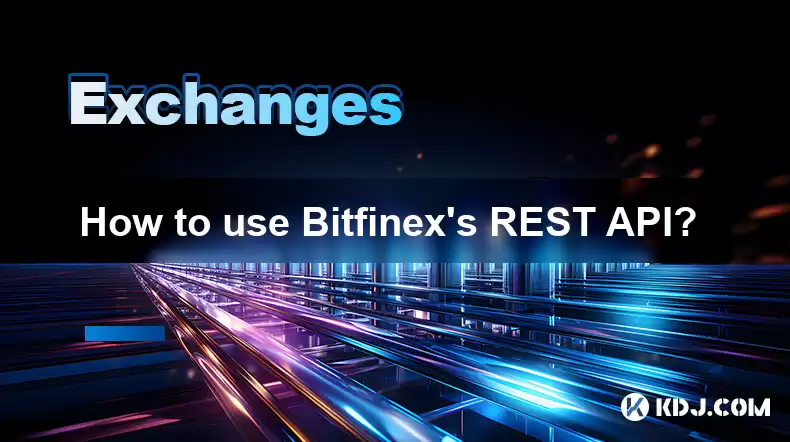-
 bitcoin
bitcoin $87959.907984 USD
1.34% -
 ethereum
ethereum $2920.497338 USD
3.04% -
 tether
tether $0.999775 USD
0.00% -
 xrp
xrp $2.237324 USD
8.12% -
 bnb
bnb $860.243768 USD
0.90% -
 solana
solana $138.089498 USD
5.43% -
 usd-coin
usd-coin $0.999807 USD
0.01% -
 tron
tron $0.272801 USD
-1.53% -
 dogecoin
dogecoin $0.150904 USD
2.96% -
 cardano
cardano $0.421635 USD
1.97% -
 hyperliquid
hyperliquid $32.152445 USD
2.23% -
 bitcoin-cash
bitcoin-cash $533.301069 USD
-1.94% -
 chainlink
chainlink $12.953417 USD
2.68% -
 unus-sed-leo
unus-sed-leo $9.535951 USD
0.73% -
 zcash
zcash $521.483386 USD
-2.87%
How to use Bitfinex's REST API?
Bitfinex's REST API lets you trade, get market data, and manage your account programmatically; this guide provides steps and examples for effective use.
Apr 14, 2025 at 03:35 am

Using Bitfinex's REST API allows you to interact programmatically with the exchange, enabling you to perform tasks such as trading, retrieving market data, and managing your account. This guide will walk you through the essential steps and provide detailed instructions on how to use Bitfinex's REST API effectively.
Getting Started with Bitfinex's REST API
Before you can start using Bitfinex's REST API, you need to set up an API key. To do this, follow these steps:
- Log in to your Bitfinex account.
- Navigate to the 'Account' section and select 'API'.
- Click on 'New Key' to generate a new API key.
- Choose the permissions you want to grant to the key, such as trading, withdrawals, or read-only access.
- Confirm the creation of the key and securely store the API key and secret.
Once you have your API key and secret, you can start making requests to the Bitfinex REST API. The API uses HTTPS and supports JSON for data exchange.
Authentication and Security
Authentication is crucial for securing your API interactions. Bitfinex uses a combination of your API key and a signature generated using your API secret. Here's how to authenticate your requests:
- Generate a nonce: A unique number that ensures each request is unique. This can be a timestamp or an incrementing integer.
- Create a payload: Combine the API path, nonce, and any additional parameters into a JSON object.
- Generate the signature: Use the HMAC-SHA384 algorithm with your API secret to sign the payload.
- Include the headers: Add the API key, payload, and signature to your request headers.
Here is an example of how to create the necessary headers in Python:
import timeimport jsonimport hmacimport hashlib
api_key = 'your_api_key'api_secret = 'your_api_secret'.encode()
Generate nonce
nonce = str(int(time.time() * 1000))
Create payload
payload = {
'request': '/v1/balance',
'nonce': nonce
}
Convert payload to JSON and encode
payload_json = json.dumps(payload).encode()
Generate signature
signature = hmac.new(api_secret, payload_json, hashlib.sha384).hexdigest()
Prepare headers
headers = {
'X-BFX-APIKEY': api_key,
'X-BFX-PAYLOAD': payload_json.decode(),
'X-BFX-SIGNATURE': signature
}
Making API Requests
With authentication in place, you can now make requests to Bitfinex's REST API. Here are some common endpoints and how to use them:
- Retrieve Account Balances: Use the
/v1/balancesendpoint to check your account balances.
import requests
url = 'https://api.bitfinex.com/v1/balances'response = requests.get(url, headers=headers)print(response.json())
- Place an Order: Use the
/v1/order/newendpoint to place a new order. You need to specify the symbol, amount, price, and order type.
payload = {
'request': '/v1/order/new',
'nonce': nonce,
'symbol': 'btcusd',
'amount': '0.01',
'price': '10000',
'exchange': 'bitfinex',
'type': 'exchange limit',
'side': 'buy'
}
payload_json = json.dumps(payload).encode()signature = hmac.new(api_secret, payload_json, hashlib.sha384).hexdigest()
headers = {
'X-BFX-APIKEY': api_key,
'X-BFX-PAYLOAD': payload_json.decode(),
'X-BFX-SIGNATURE': signature
}
url = 'https://api.bitfinex.com/v1/order/new'response = requests.post(url, headers=headers)print(response.json())
- Retrieve Market Data: Use the
/v1/pubtickerendpoint to get the current ticker for a specific trading pair.
url = 'https://api.bitfinex.com/v1/pubticker/btcusd'response = requests.get(url)print(response.json())Handling Errors and Responses
When using the Bitfinex REST API, it's important to handle errors and interpret responses correctly. Here are some tips:
- Check the HTTP status code: A 200 status code indicates a successful request, while other codes indicate errors.
- Parse the response JSON: The response will contain a JSON object with the requested data or error messages.
- Common error codes: Familiarize yourself with common error codes like 400 (Bad Request), 401 (Unauthorized), and 500 (Internal Server Error).
Here's an example of how to handle errors in Python:
import requests
url = 'https://api.bitfinex.com/v1/balances'response = requests.get(url, headers=headers)
if response.status_code == 200:
print('Request successful:', response.json())
else:
print('Error:', response.status_code, response.text)
Using WebSockets for Real-Time Data
While the REST API is suitable for many tasks, using WebSockets can provide real-time data updates. To connect to Bitfinex's WebSocket API, follow these steps:
- Establish a WebSocket connection: Use a WebSocket library like
websocket-client in Python.
import websocket
ws = websocket.WebSocket()ws.connect('wss://api-pub.bitfinex.com/ws/2')
- Subscribe to channels: Send a JSON message to subscribe to specific channels, such as ticker or order book updates.
subscribe_msg = {
'event': 'subscribe',
'channel': 'ticker',
'symbol': 'tBTCUSD'
}
ws.send(json.dumps(subscribe_msg))
- Process incoming messages: Parse the incoming JSON messages to handle real-time data.
result = ws.recv()print(result)Managing API Rate Limits
Bitfinex imposes rate limits on API requests to prevent abuse. To manage these limits effectively:
- Understand the limits: Bitfinex has different rate limits for authenticated and unauthenticated requests. Authenticated requests are typically limited to 90 requests per minute.
- Implement rate limiting in your code: Use libraries like
ratelimitin Python to ensure you stay within the limits.
from ratelimit import limits, sleep_and_retry
@sleep_and_retry@limits(calls=90, period=60)def call_api():
# Make your API call here
pass
Use the function
call_api()
Frequently Asked Questions
Q: Can I use Bitfinex's REST API to automate trading strategies?A: Yes, you can use the REST API to automate trading strategies by programmatically placing orders, checking balances, and retrieving market data. Ensure you implement proper error handling and rate limiting to maintain a stable trading environment.
Q: Is it possible to withdraw funds using the Bitfinex REST API?A: Yes, you can withdraw funds using the /v1/withdraw endpoint. You need to specify the withdrawal method, amount, and address. Make sure you have the necessary permissions on your API key to perform withdrawals.
A: Bitfinex offers a testnet environment where you can test your API requests without affecting your live account. You can sign up for a testnet account and use the testnet API endpoints to simulate trading and other operations.
Q: What should I do if I encounter an authentication error?A: If you encounter an authentication error, double-check your API key, secret, and the signature generation process. Ensure the nonce is unique for each request and that the payload is correctly formatted. If issues persist, consider regenerating your API key and secret.
Disclaimer:info@kdj.com
The information provided is not trading advice. kdj.com does not assume any responsibility for any investments made based on the information provided in this article. Cryptocurrencies are highly volatile and it is highly recommended that you invest with caution after thorough research!
If you believe that the content used on this website infringes your copyright, please contact us immediately (info@kdj.com) and we will delete it promptly.
- Mastering Marina Protocol: Your Guide to Crypto Rewards and Daily Quizzes in 2025
- 2025-11-30 23:50:01
- Memecoins, Utility Coins, and Market Highs: A New York Minute on Solana's Shift
- 2025-11-30 23:40:01
- AI, US Stocks, and Economic Updates: Navigating the Fog
- 2025-11-30 23:45:01
- ALT5 Sigma Corporation (ALTS): A High-Risk Bet in the Crypto Infrastructure Arena
- 2025-11-30 23:45:01
- Bitcoin Cash (BCH) Price Forecast: Riding the Crypto Wave into 2025?
- 2025-11-30 23:40:01
- Lido wstETH: Navigating Price Forecasts and News in Late 2025
- 2025-11-30 23:20:01
Related knowledge

How to Buy XRP on Uphold vs. Coinbase: A Full Comparison
Nov 30,2025 at 06:00pm
Platform Overview: Uphold and Coinbase1. Uphold is a multi-asset digital money platform that supports trading in cryptocurrencies, fiat currencies, pr...

A Beginner's Guide to Withdrawing from KuCoin
Nov 30,2025 at 01:39pm
Understanding KuCoin Withdrawal Basics1. KuCoin is a global cryptocurrency exchange that allows users to trade and manage digital assets. Withdrawing ...

How to Stake Cardano (ADA) on Kraken: A Full Tutorial
Nov 30,2025 at 03:00pm
Setting Up Your Kraken Account for ADA Staking1. Navigate to the official Kraken website and click on the “Sign up” button to begin account creation. ...

The Ultimate Guide to Identity Verification (KYC) on Binance
Nov 30,2025 at 05:19pm
Understanding KYC on Binance1. Know Your Customer (KYC) is a mandatory process implemented by Binance to comply with global financial regulations. Thi...

A Beginner's Guide to Crypto Derivatives on OKX.
Nov 28,2025 at 07:20pm
Understanding Crypto Derivatives on OKX1. Crypto derivatives are financial instruments that derive their value from an underlying cryptocurrency asset...

How to Buy USDT on OKX: A Full Guide.
Nov 27,2025 at 05:59pm
How to Register on OKX and Set Up Your Account1. Navigate to the official OKX website and click on the “Sign Up” button located at the top right corne...

How to Buy XRP on Uphold vs. Coinbase: A Full Comparison
Nov 30,2025 at 06:00pm
Platform Overview: Uphold and Coinbase1. Uphold is a multi-asset digital money platform that supports trading in cryptocurrencies, fiat currencies, pr...

A Beginner's Guide to Withdrawing from KuCoin
Nov 30,2025 at 01:39pm
Understanding KuCoin Withdrawal Basics1. KuCoin is a global cryptocurrency exchange that allows users to trade and manage digital assets. Withdrawing ...

How to Stake Cardano (ADA) on Kraken: A Full Tutorial
Nov 30,2025 at 03:00pm
Setting Up Your Kraken Account for ADA Staking1. Navigate to the official Kraken website and click on the “Sign up” button to begin account creation. ...

The Ultimate Guide to Identity Verification (KYC) on Binance
Nov 30,2025 at 05:19pm
Understanding KYC on Binance1. Know Your Customer (KYC) is a mandatory process implemented by Binance to comply with global financial regulations. Thi...

A Beginner's Guide to Crypto Derivatives on OKX.
Nov 28,2025 at 07:20pm
Understanding Crypto Derivatives on OKX1. Crypto derivatives are financial instruments that derive their value from an underlying cryptocurrency asset...

How to Buy USDT on OKX: A Full Guide.
Nov 27,2025 at 05:59pm
How to Register on OKX and Set Up Your Account1. Navigate to the official OKX website and click on the “Sign Up” button located at the top right corne...
See all articles










































































